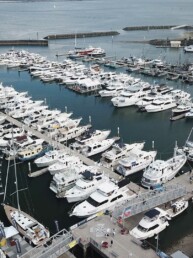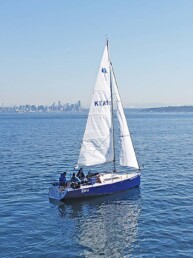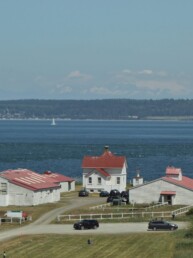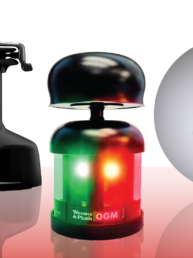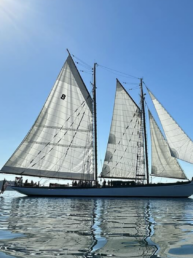A History, and Review of the 2020 Sailing Season
From the December 2020 issue of 48° North.
A successful season of racing on Port Townsend Bay has come to an end. At the center of the planning and implementation, as every year, was the Port Townsend Sailing Association (PTSA). And once again, the Thunderbirds were the big local fleet.
Many 48° North readers will be familiar with the venerable Thunderbird, but the boat’s rich Pacific Northwest history is nearly matched in intrigue by the recent coalescence that brought a fleet home to Port Townsend, and Port Townsend sailors to this fleet.
Ben Seaborn penned his design for the Thunderbird in response to a 1958 challenge by the Douglas Fir Plywood Association for a design that could be “both a racing and a cruising boat … sleep four … capable of being built by reasonably skilled amateur” and, crucially, “outperform other sailboats in its class.” And it did. By 1980, there were more than 1,000 Thunderbirds sailing. Perhaps more impressively, the class association received more than 25,000 requests for the building plans (which first cost $2, and are available today for $60).
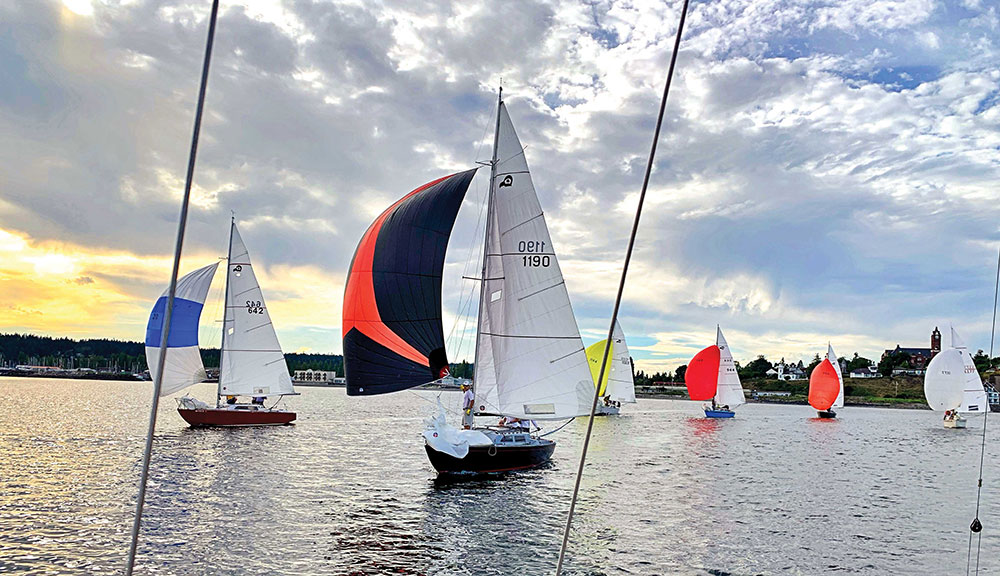
Thunderbirds immediately showed their speed, beating many larger and more expensive boats. Three sailing enthusiasts in Port Townsend — Jim Daubenberger, who owned a clothing store on Water Street, attorney Glenn Abraham, and physician Bill Scheyer — took notice. In 1963, they commissioned hulls 241 (Zaca), 242 (Dorado), and 243 (Caveat) from Bill Knottingham Marine in Tacoma.
“The boats were inexpensive,” says Jim’s son, Joe Daubenberger. “In 1963, the bill of sale for these Thunderbirds was $2,650, including sails and other options,” said Joe in a tribute to his father in the Port Townsend Leader. That’s a little less than what this author paid for a Thunderbird (Falcon, #1177) two summers ago.
Putting that in perspective, median income in the greater Seattle Area in 1960 was $6,225, so the purchase of a new Thunderbird in 1960 set you back nearly one half year’s median income in Seattle. Even back then, a Thunderbird was not so inexpensive for most people. Today, median income in metropolitan Seattle is $102,500 (2019) and you can purchase a new J/80 (also 26 feet) for $55,000 — or a little more than one half of a year’s median income. The Thunderbird was the J/80 of 1960. Well, not quite as fast, but much better to cruise!
As the years went on and the region’s economy boomed, more sailors were able to afford bigger, faster boats. In Port Townsend, too, Jim Daubenberger, Bill Scheyer, and Glenn Abraham moved on to bigger boats and longer races. Zaca, Dorado, and Caveat were sold off and fell on hard times, neglected, down on Bainbridge Island, in Port Hadlock, and Port Ludlow. But you couldn’t keep the Thunderbird and Port Townsend sailors apart long.
In 2000, Scott Walker purchased an old woodie, Tzieu, which he lovingly restored to pristine condition. John Carey had Coco Solo and raced it avidly. In 2008 Joe Daubenberger attended the 50th anniversary party for the Thunderbird. The event also marked the launch of a beautiful new woodie, Thunderbaby (#1255), which turned out to be the last Thunderbird built. “We kept running into someone who said ‘I have your dad’s old T-bird,’” says Joe Daubenberger. The Daubenbergers found Zaca in Port Ludlow, and Dorado in disrepair and with a foul bottom. Both were brought to Port Townsend and restored. Caveat was at the Wooden Boat Center. The three original Port Townsend Thunderbirds had returned like prodigal sons.
Suddenly, there was the core for a one-design fleet in Port Townsend. Glenn Abraham’s daughter Anne and her husband, Doug Bolling, owned Raven which they painted shiny black. John Lynes purchased his first Thunderbird in 2008. The Bollings acquired the old family boat, Caveat, from the Wooden Boat Foundation in a trade, and they sold Raven to Stig Osterberg and Steve Scharf. Piper Dunlap acquired Blew Bird and later Magic Bus with fellow 505 sailors. Dale Dunning, the president of the International Thunderbird Association, brought his boat Water Torture to Port Townsend in 2013, and acquired Owl from the Victoria fleet in 2016.
Of such stuff a one-design fleet is made: energy, camaraderie, and an infatuation with these funky old boats that are fun to sail, truly inexpensive in this day and age, and still fast. Now, there are many others in Port Townsend. Steve Scharf has personally brought in three boats and has donated a motor yacht committee boat, which is staffed by a regular committee. The Port Townsend fleet was incorporated as International Thunderbird Fleet 33. It is vibrant. And growing.
In 2020, the year’s on-water sparring began informally in January, with several Thunderbirds and Bertram Levy’s Murrelet gathering on Saturdays and sailing up to the mooring buoys off Fort Worden, down to the green buoy off the naval facility on Indian Island, and across to the wooden tower off Rat Island — the old anchor point for an anti-submarine net that stretched across Port Townsend Bay during World War II.
Twenty-six boats — a happy gaggle of 505s, classic woodies new and old, plastic fantastics, and eight Thunderbirds — showed up to mark the leap year on February 29 for the Shipwright’s Regatta, under snow-capped peaks. Dorado, Raven, and Kuma San took top honors in the Thunderbird class.

With the state in Coronavirus lockdown, six-to-eight Thunderbirds raced informally, with family units, single-handed, or double-handed on Saturdays from March through May. To keep things even, a decision was made not to use flying sails and to use the working jib as a headsail. This proved to be a popular solution and became the model for the formal PTSA racing during the balance of the year.
PTSA sponsored their Midsummer (June), Catspaw (July), and Dog Days (August) series, which consisted of Wednesday night windward/leeward courses and Friday night romps around the Bay starting and finishing at City Dock. The Wednesdays turned out to be a one-design event for the Thunderbirds. Fifteen Thunderbirds showed up in total, with 7-12 boats on the line each week. Corvo, Owl, and Dorado dominated the summer with Corvo winning the first two, and Owl and Dorado trading second and third. Dorado won the third series, with Raven second, and Owl third.
Eleven total boats turned out for the annual Ted Pike Regatta, held on August 22. This is a quintessential Port Townsend event. In normal years it starts on the beach below the Marine Science Center in Le Mans fashion. One crew member from each boat rows, paddles, or swims from the beach to their boat to be pulled up by eagerly waiting crews who may not hoist sail or begin to weigh anchor until the marooned sailor has rejoined the boat. The first turning mark is off the beach near the Point Wilson lighthouse, where the fleet surprised a family on their trawler enjoying lunch tied to a mooring buy. This year the start was from “at anchor,” but the finish still involved sending a swimmer to shore to drink a double shot of rum and ring a bell at the Northwest Maritime Center. Thunderbirds Corvo and Falcon were the top two finishers.
Owl won the single light air race of the Fall Thunderbird Regatta, followed by Raven and Magic Bus. The racing for this season concluded with the Saturday Nightcap series. Raven, Owl, and Corvo bested a field of 10 boats in the Thunderbird fleet.
Many of this year’s races have been documented on video by Dale Dunning. Check out his YouTube Channel at OP Sailing for coverage of the Thunderbird fleet.
The wind is full of promise for sailing on Port Townsend Bay next year. Classic wooden boats, fast modern racers, and funky still-fast old boats will keep the sailing in Port Townsend diverse and interesting.
Photos courtesy of Thunderbird Fleet 33.

